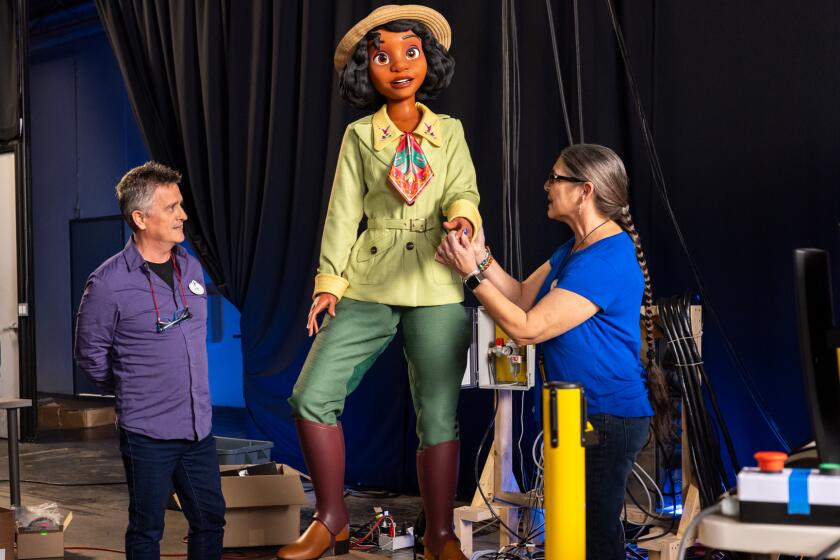‘Mike’s Place’ tells the true story of terror in a Tel Aviv blues bar
Back in 2003 when filmmaker Jack Baxter first visited Mike’s Place, a beachfront blues bar in Tel Aviv, he envisioned making a documentary about a venue where Jews, Muslims, tourists and expats could gather in peace and leave their differences at the door.
The bar had a rule -- no discussing politics or religion -- that appealed to the region’s young people who just wanted to let loose and enjoy themselves.
But Baxter couldn’t have predicted that a few weeks into filming, Mike’s Place would be attacked by a suicide bomber. The blast killed three people and left 50 injured, including Baxter. Baxter and Israeli filmmaker Joshua Faudem finished the documentary, “Blues by the Beach,” about the lead-up to the bombing and the bar’s rebirth after the tragedy.
------------
For the Record
June 11, 12:57 p.m.: An earlier version of this article said that the suicide bomber was Palestinian. He was British.
------------
More than a decade later, the filmmakers teamed up with Israeli-born illustrator Koren Shadmi to adapt their experience into a graphic novel. The result is “Mike’s Place: A True Story of Love, Blues and Terror in Tel Aviv,” out Tuesday from First Second Books.
Baxter, from New York, will be in Los Angeles June 25 for a book signing and film screening hosted by the Anti-Defamation League. Baxter will also be speaking and signing books at Skylight Books in Los Feliz on June 26.
Hero Complex interviewed Baxter via email about the book, his experiences in Tel Aviv and the unique spirit behind the bar on the beach.
How did this project come about? What made you decide on a graphic novel as the medium for this story, a decade after the documentary?
Late in 2005, literary agent Jerry Rudes suggested I write a nonfiction book about my personal experience with the Mike’s Place terror attack. Investigators had recently revealed new information about the two British terrorists who perpetrated the April 30, 2003, suicide bombing. These fresh facts not only updated data about the Tel Aviv attack but exposed an international conspiracy, making the story much, much bigger -- the Mike’s Place terrorists, Asif Hanif and Omar Khan Sharif, had a direct connection to Mohammad Sidique Khan, the mastermind of the July 7, 2005, London transit attacks.
Anyway, I went back to Israel for the first time since the bombing in March 2006 for more medical treatments. I interviewed other survivors, and then I started writing. When I got back to New York two months later, Jerry and I took meetings with publishers and even a ghostwriter. But my heart just wasn’t in it back then and the project gathered dust.
In 2010, my cowriter Joshua Faudem said we should write a screenplay and turn “Blues by the Beach,” our personal stories, and my interviews into a movie. I’d written a couple screenplays -- that are still in my drawer. So, this time out, I took an intensive creative writing seminar with script guru Robert McKee to get the narrative structure and three-act drama architecture down pat. Joshua and I finished it almost two years later. Then we experienced the usual showbiz games -- people promising the moon, deals falling through.
In April 2012, First Second Books publisher-editor Mark Siegel saw the documentary, read the screenplay and said it would make a great graphic novel. And here we are today, more than 12 years from that crazy night in Tel Aviv on April 30, 2003.
The book is based on real events you experienced and recorded. How much of the script from the graphic novel comes from your memories and how much comes from your tapes?
I can’t really break it down off the top of my head. But I’m sure there’s a way of doing the math and coming up with proportions. The ingredients are all blended together now and part of the same dish.
How did you collaborate with Joshua Faudem on the graphic novel?
Mark Siegel provided us with his graphic novel format template. Joshua came in from Israel or Canada, or was it Ukraine? I can’t keep up with that guy. Anyhow, we got together every day for weeks reading through the screenplay, watching the film, discussing, taking notes. Then I would type, edit, rewrite and retype. And then my wife, Fran, would help import it into the format program -- computers are still a mystery to me. We’d all read it aloud and discuss more edits. And then we’d go through the process again until it cut the mustard.
And after Mark Siegel and First Second put their two cents in, we were done.
In your epilogue, you mentioned the need to fictionalize certain aspects of the story. Which aspects and why?
I’m not going to get too far into the weeds here and spoil the plot. I’m also not going to show all our cards and explain why it was necessary to fictionalize certain aspects. But I want you and your readers to know that our story is true and depicts real events and real people.
Mohammad Sidique Khan, the future-mastermind of the 7/7 London Transit Attacks, traveled to Israel on Wednesday, Feb. 19, 2003, and stayed only one-day in Tel Aviv. This is a fact. Exactly nine weeks later, his friends, Asif Hanif and Omar Khan Sharif, attacked Mike’s Place on April 30, 2003. This also is a fact.
Now, why did Khan fly into Ben Gurion [Airport] for only one day? Did Khan take a walk on the Tel Aviv beachfront promenade? Did Khan see that the American Embassy was right next door to Mike’s Place? Did Khan go to the bar and have a pint of Guinness and flirt with a beautiful cocktail waitress?
What I do know is that there are published articles from researchers who believe that Asif Hanif and Omar Khan Sharif were helped by personal info and intelligence supplied to them by their mutual close friend, Mohammad Sidique Khan, upon his return to London.
No, I didn’t see Mohammad Sidique Khan at Mike’s Place, nor do I know the personal conversations between Asif Hanif and Omar Khan Sharif. But I can conjecture, make supposition, and draw conclusions based on best evidence.
And with the advantage of informed and educated hindsight, a true story based on facts emerges about the terrorists who conspired to kill as many people as they could at an international live-music blues bar next door to the U.S. Embassy, just hours before the American-backed Middle East Roadmap Peace Plan was presented to the Palestinians and Israelis later that morning of April 30, 2003.
You and Joshua are obviously very close to the events of the book. What was it like to collaborate with artist Koren Shadmi? What did Koren bring to the table?
After Koren saw the film and read the screenplay and signed up, Mark took us all out for a Japanese lunch and we shook hands. Koren is a professional, award-winning illustrator who knows the graphic novel process. He gave us his rough sketches; we made our comments and asked for very few changes. Then Koren put his pen to the panels and created the cover art with input from everyone. In my obviously biased opinion, Koren Shadmi is going to take his place among the best -- Will Eisner and R. Crumb and Art Spiegelman.
Oh, and Koren’s a great guy besides.
The story shows Mike’s Place was special because it offered a haven where people of all religions and political backgrounds could put aside their differences and enjoy a good time together. How did you go about showing compassion for all sides in your narrative?
People are people. Characters drive the plot in story and in life. It’s one of the basic requirements of storytellers, to put themselves in somebody else’s shoes. Even suicide bombers are not excluded from authors and artists’ empathy.
Looking back at the bombing a decade later, are your feelings and your thoughts different now than they were in its immediate aftermath? Is there wisdom or perspective or healing to be gained with time?
After I awoke from my coma, I was told who died and who else was wounded. I learned how Mike’s Place bouncer Avi Tabib fought Asif Hanif and prevented him from getting into the bar and killing everybody. That’s real courage, real heroism. I can give you some platitude like “time heals all wounds” but …
My wife and I are part of a terrorism survivor organization called Strength to Strength headed by Sarri Singer, who survived a June 2003 Jerusalem bus bombing. Everybody around her was dead and in pieces. Over the years, Sarri’s introduced us to 9/11 and 1995 Oklahoma City survivors; Irish Catholic and Irish Protestant survivors of “The Troubles”; 2008 Mumbai Massacre survivors; Africans and Arabs and Jews. Sarri Singer is another hero of mine.
But the true hero for me is my wife, Fran. She is the reason there is the “Blues by the Beach” film and the “Mike’s Place” graphic novel. Not only is Fran still nursing me back to health, she took on all the responsibilities of producing what she believed to be an important story. A true story that could change perceptions and offer at least a hope better days are ahead for Israelis and Palestinians. She’s put up with hassles and false friends and most of all me. We put our life savings into this story, and have never made a dime. And despite everything that’s happened the last 12 years, Fran still loves me.
I love you, Franny.
Have you been back to Tel Aviv since the events of the book? What was that like?
In 2008, Fran and I went back together the second time. We stayed eight days and shuttled back and forth from Tel Aviv to Jerusalem, where we stayed with Joshua’s parents, Burt and Arlene Faudem. We had a great time. By that time, the horrors of the second intifada were starting to fade from memory for the Israelis.
What do you hope people take away from reading the graphic novel?
Movie producer Sam Goldwyn said: “If you have a message, call Western Union.” I just want people to read and look at our story and take from it what they find for themselves. And, I want “Mike’s Place” translated into every language in the world. Is that too much to ask?
On Twitter: @noeleneclark
More to Read
The biggest entertainment stories
Get our big stories about Hollywood, film, television, music, arts, culture and more right in your inbox as soon as they publish.
You may occasionally receive promotional content from the Los Angeles Times.






